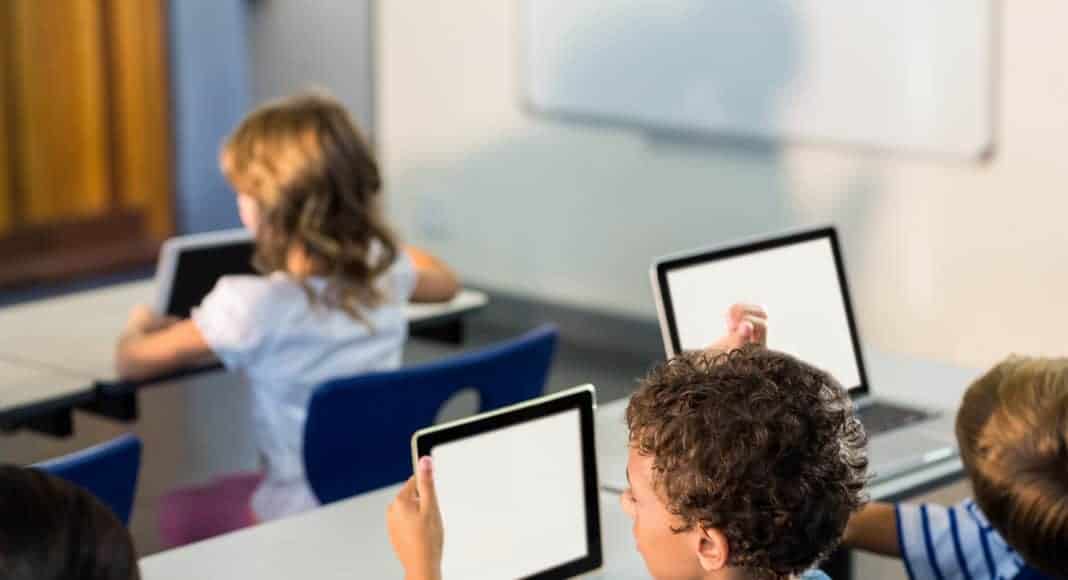The rapid pace of innovation and change has revolutionized education by providing widespread access to information, facilitating communication & collaboration, transforming teacher roles into facilitators, and accommodating diverse learning styles.
The Pandemic forced schools to adopt ten years’ worth of digital transformation in under a month. Today, we live in a fast-moving world where using technology in the classroom is no longer an option; it is essential.
The use of the Internet and the adoption of mobile devices like smartphones are widespread, and digital technologies play a significant role in the everyday lives of American families.
Children today begin interacting with digital technology at a young age.
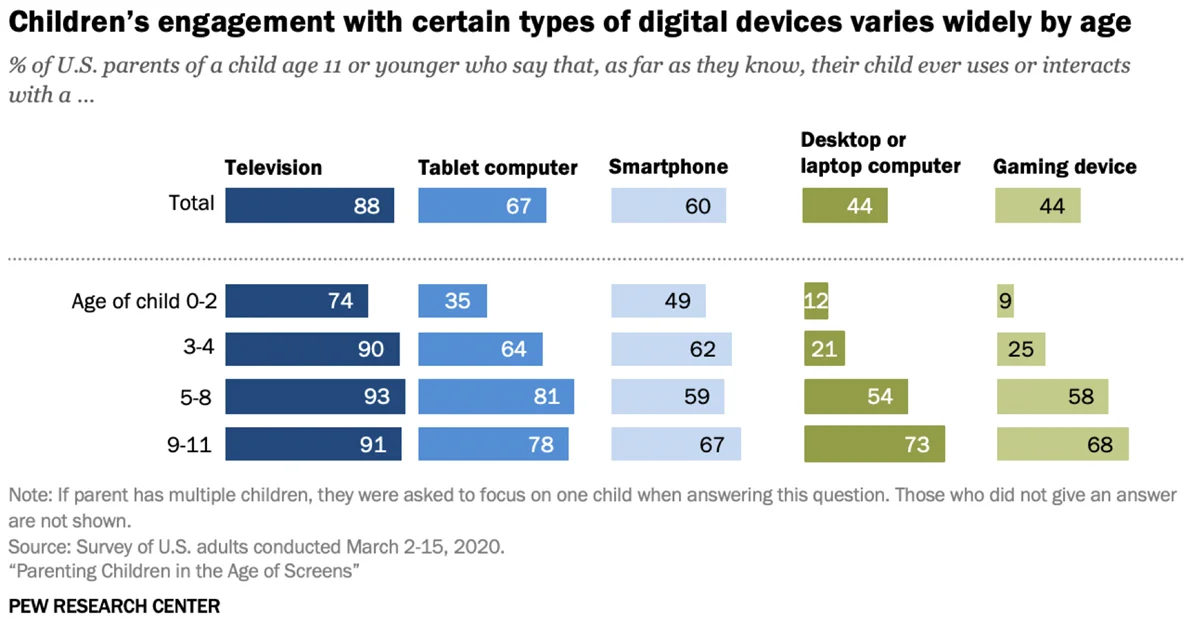
The students we teach live in a world dominated by devices and apps. It’s their window into the world around them. From social life to learning, the digital world is where they exist.
This is NOT going to go away!
This will only become more prevalent in the coming years. As teachers, we can either embrace this and succeed or ignore it and fail.
Sorry to be blunt; that’s the truth. If you want your students to be engaged and take ownership of their learning, we need to adapt our practices to their world, not expect them to adjust theirs to ours.
Need more convincing? Read on.
What are the Benefits of Using Technology in the Classroom?
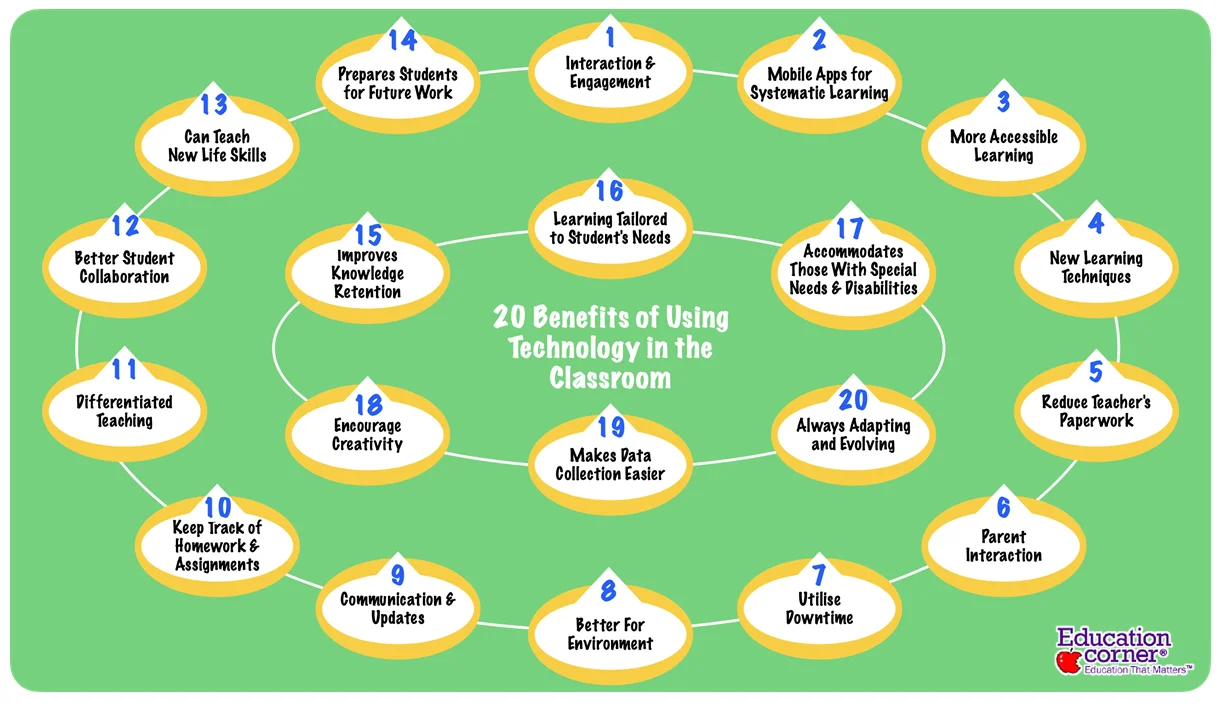
Let’s find out in more detail!
1. Enhance Interaction and Increase Student Engagement
Experts say that using technology in teaching and learning can increase children’s engagement in class much more than an old-school textbook can. This is also true because a significant part of students’ lives today revolves around devices and apps—that’s where they live.
Teachers can use apps to support learning and benefit learners of all levels and abilities. Apps also equip teachers with new ways of teaching the same thing – from games to virtual field trips.
Compared to traditional approaches, these activities create more opportunities for active participation in the learning process.
A World Bank report found that introducing blended learning styles helps keep students focused for extended periods and can increase engagement, especially for STEM (Science, Technology, Engineering, and Math) subjects.
Mobile learning allows for more personalization than most paper or physical resources and can be tailored to a child’s specific needs. Learning no longer needs to be a passive activity – with the use of apps, it can become very active and engaging.
For example, level-based educational apps, similar to video games, can motivate students to progress and increase their determination. They combine education with entertainment, which makes students forget they are doing schoolwork—boom, ninja learning!
2. Mobile Apps Help in Systematic Learning
Classroom apps can be arranged to promote a child’s craving for learning and track their progress as they attempt to advance through the levels. Studies show that teachers are optimistic about the role technology could play in empowering children and young people.
A study by PBS LearningMedia found that 74% of teachers agreed that technology enables them to solidify learning in their lessons. Another survey by Smoothwall found that 96% of teachers believe technology has positively impacted how children participate and learn.
These apps capture students’ attention through gamification, animation, and interactive elements and motivate them to learn. They also facilitate information retention, as the content is arranged in an entertaining manner that reduces the cognitive burden.
Read about a helpful review of the 35 of the BEST educational apps for teachers
3. Mobile Learning Is Accessible Any Time, Any Place
M-learning stands out as a valuable solution due to its convenience and accessibility. It enables individuals to learn from anywhere, anytime, eliminating the need to carry physical materials.
Teachers can use educational apps to engage students anytime during the school day, essentially creating a “Borderless Classroom.”
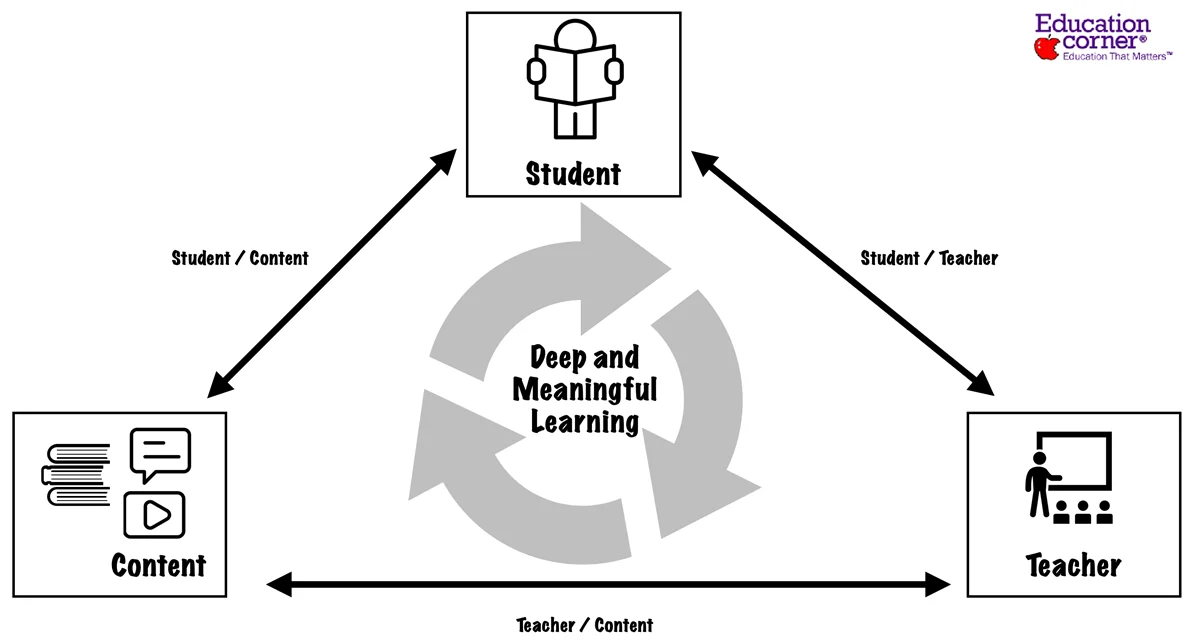
With hundreds of thousands of apps to choose from, it’s possible to find an app for almost every educational need. In fact, the educational app sector is the second largest in the Google Play Store and the third largest in the Apple App Store.
This is proof that such apps are popular learning tools that students use both inside and outside the school. Incorporating mobile apps in class can increase engagement and reduce misbehavior both in class and at home—a double win!
You never know; you could actually get an entire class to submit a homework assignment…the holy grail, right?
Many of these apps use embedded videos to explain topics more clearly than a textbook (the same textbook students forget, lose, or do not bother to carry around). Apps also reduce paper use, which is a more environmentally responsible choice (See point 8).
Apps also increase collaboration when students use them as research tools in projects and group work (I have seen this with my own eyes in my classes). Students can also use mobile applications to access a vast array of eBooks, PDFs, and other online materials.
These apps make researching materials easier. Many students still can’t remember how to use a book index/content page!
Teachers can use in-classroom internet research to teach students how to effectively search for reliable content so that they avoid using content not aimed at the appropriate level. After all, it is common to see students work with paragraphs of copied/pasted content they don’t really understand (usually because they accessed a university website!).
4. Technology Offers New Learning Techniques
Research on learning theories suggests that games and puzzles, which many educational apps use, can stimulate brain activity. This offers students who feel they have ‘hit a wall’ in certain areas of learning a chance to tackle the challenge from a different direction.
Learner’s engagement can be increased by introducing varied learning methods. Because of the ever-increasing number of educational mobile apps, this can be achieved with ease without incurring significant costs. Many such apps are free to download for students.
5. Apps Enable Teachers to Decrease Paperwork
According to a McKinsey study, K-12 teachers work about 50 hours a week but spend less than half that time in direct interaction with students:
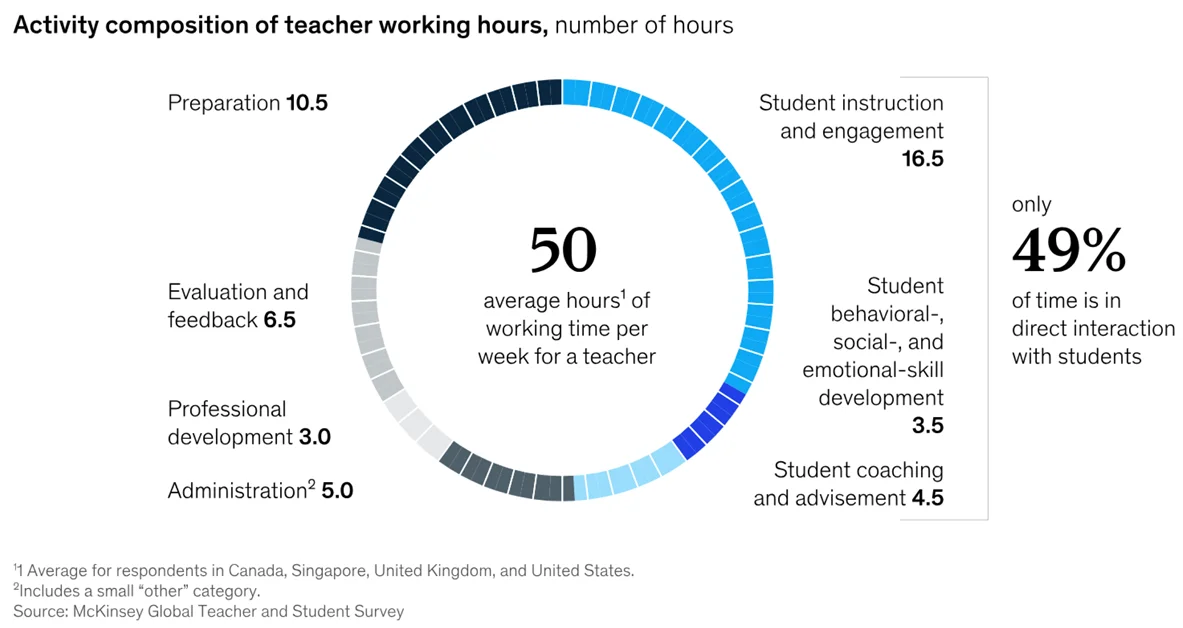
Many of these activities, such as preparation, administration, evaluation, and feedback, involve a lot of paperwork, which is a challenge for all teachers. Because teachers’ work is heavily legislated, it requires bureaucratic record-keeping.
Federal education initiatives such as the Common Core Standards have increased the accountability requirements for nearly all public school educators.
Teachers can save time by using apps in many ways. They use standardized templates and spreadsheets to automate repetitive tasks.
Software like SpedTrack makes it easier to create Individualized Education Programs (IEPs), while apps like RethinkBH help teachers with more complex tasks, such as assessing and addressing student’s behavioral issues.
Then, there are caseload trackers that allow teachers to track student information, update learning goals, and manage deadlines. Less specialized applications, including Evernote, are useful for taking notes as classroom events happen and help increase the accuracy of reporting.
These are only some examples of the many ways in which good tech can help ease the paperwork burden for teachers.
Using technology can free up a significant amount of time and help teachers achieve a better work-life balance.
By switching from paper to digital data, it becomes easier to gauge students’ learning difficulties, modify the instructions, and customize learning for better outcomes.
Big data and learning analytics, for instance, can bring significant benefits, such as improving the e-learning environment, understanding learners’ behavior, and advancing learning strategies.
6. Classroom Apps Can Benefit Parents
Technology in the classroom is not exclusive to students and teachers; it can also benefit parents in several ways:
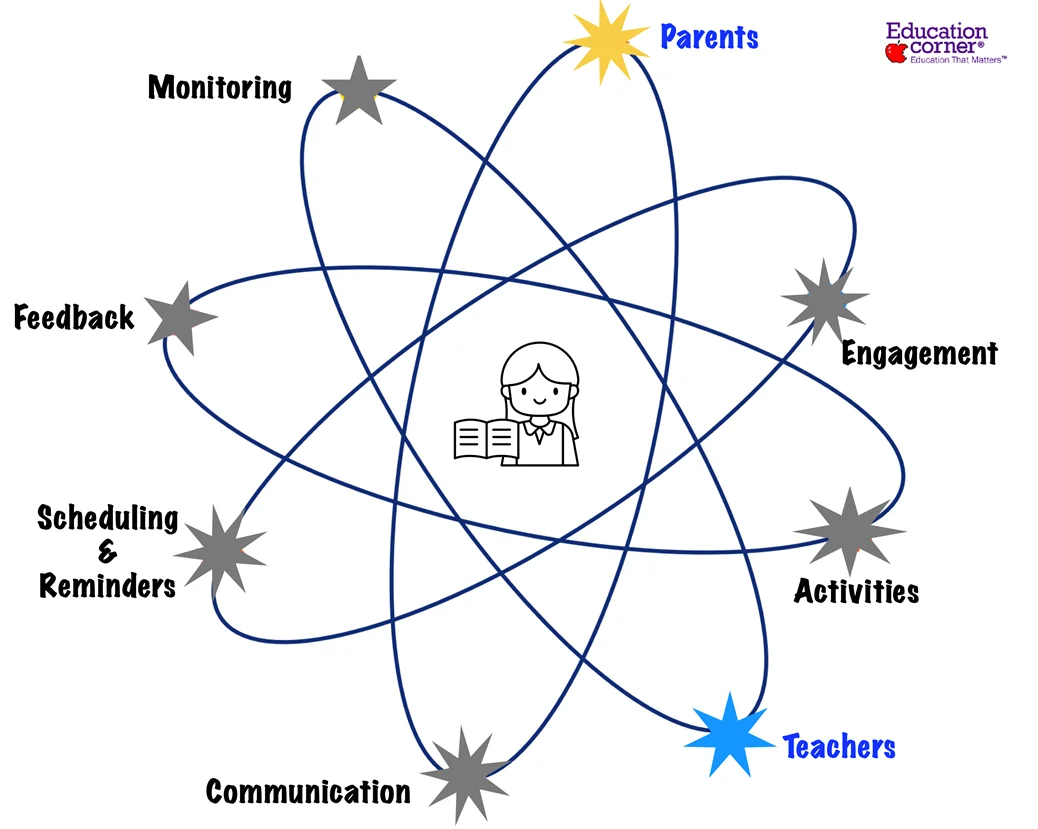
- Improved Communication: School management apps provide a centralized platform for effective communication among parents, teachers, and students and offer easy access to crucial information.
- Engagement: these apps enhance student-parent engagement by keeping parents updated about school activities and allowing customization of notifications.
- Parental Involvement: they support parental involvement by providing resources for parents to assist with reading, homework, and tutoring .
- Monitoring Student Progress: include tools that allow parents to track their child’s performance, attendance, and school announcements.
- Feedback Mechanism: make it easier for parents to provide feedback or report concerns, enabling educators to make improvements faster.
- Scheduling and Reminders: streamline the planning process by making it easier to schedule meetings with teachers and providing reminders for important dates.
- Document Sharing: simplify the sharing of documents like report cards and assignments, reducing the need for physical paperwork.
As teachers, we know that involving the parent in a child’s education is an important step to student success, and these apps help make the process easier in this modern age.
Google Suite (Docs, Sheets, and Slides), for instance, allows working documents to be shared electronically. These can then be easily brought together through Google Classroom. Students and parents can share them so their carers can read through them and offer advice.
This is perfect for working parents who may not have the time to sit down and go through their child’s work with them at home but can still do this during their lunch break.
7. Students Can Utilize Their Downtime
A further benefit for parents is that educational apps offer an excellent way for their child to utilize their downtime. Most parents relate to the image of a child begging for more screentime time on the iPad!
Educational apps provide a middle ground by helping students utilize their downtime with educational opportunities and productive activities. They allow for a compromise in which the child is happy to use their mobile device while the parent can be guilt-free, knowing their child is learning new skills.
8. Classroom Apps Are Better for the Environment
On average, a school uses 2,000 sheets of paper a day. One study found that in just a year, a school will consume 320,000 sheets of paper, which is about 32 billion sheets of paper in total for all the schools in the US.
Stacked together, the height of that much paper would be nearly eight times that of Mount Everest!
There is no doubt that paper enhances students’ learning. Taking notes, writing essays, and everything related to handwritten work enables students to learn in ways technology cannot. However, there are also unnecessary uses of paper, such as textbooks, assignments, forms, and instructions, which can be accessed online, and needless printing can be avoided.
For instance, by implementing a pupil learning platform, educators can effortlessly provide resources and homework tasks to each student without using paper. Forms can also be exchanged between the school and parents online.
This benefits the wider world. Millions of trees are cut down every year to make paper resources for classrooms. If all schools incorporated Edtech in teaching and learning, the damage to the environment would drastically reduce.
9. Technology Keeps Staff and Pupils Updated and Connected
Many educational apps can send alerts about events, timetables, and other important information as they near the deadline. They are also the best way for students to stay connected with their teachers, as they can send direct messages and get quick responses.
Some software also allows students to make payments, such as lunch money and library dues, saving time and effort of standing in a queue at school. Similarly, attendance-management software makes it easier for teachers and parents to track attendance.
Apps help decrease the communication gap between pupils and the school by keeping them updated about everything from new schedules to after-school activities.
Class calendars and classrooms, for example, are a great way for teachers to share everything from assignments to planned in-class activities. Students can check class information anywhere and avoid stressing about missing a task or homework!
You can even include parents in the calendar so they can see what their children are meant to be working on.
Student safety is another high-priority area where technology can make a significant difference (though it’s not the sole solution).
From early threat detection to real-time incident analysis to informed communication for a more rapid and efficient response, technology makes it all possible. Students can also record suspicious behavior on school campuses and report it anonymously.
10. Apps Ensure Homework and Assignments Are No Longer Lost or Forgotten
By utilizing technology smartly, students can ensure they never forget their homework and assignments (gone are the days of “the dog ate my homework!”).
Google Drive, for example, can be a great place to save all assignments. As one works,
Google Docs/Sheets/Slides automatically save every change made in almost real-time. This means it will be available even if your computer bursts into flames!
Students can rest easy knowing their work is securely stored in the cloud.
Indeed, some schools have already adopted a system where students turn in their papers in a strictly digital format. Teachers can even set up push notifications to send their students reminders to do their homework.
Students often forget to complete homework, and smart notifications can help remind them of their academic duties.
According to research, students showed improvement in math when they completed additional practice at night. Reminders could prove useful in helping students achieve their academic goals by prompting them to do more revision.
In fact, app developers confirm that push notifications are one of the best ways to get students to engage with educational apps.
11. Classroom Apps Enable Teachers to Further Differentiate Their Teaching
In a class of 20-plus pupils, all with their own individual needs, it is very difficult for teachers to engage with each child in every lesson. This results in some students losing track of the lesson or struggling to grasp new topics because they have not mastered the previous one.
Ed-tech apps help by encouraging children to learn at their own pace, whether in class or outside. They offer greater flexibility in learning.
Teachers, too, can review content as needed and monitor progress using analytics and assessment tools. Learning sessions can be tailored to each child’s unique needs without having to address multiple students at the same time.
12. Education Apps Enable Collaboration Between Students
Technology offers many opportunities for collaboration between students. For example, with Google Suite apps, students can work on the same document together at any time. Features like annotating and suggestions allow pupils to continue to collaborate outside the classroom.
Video calls are another great way for students to collaborate. Google Meet’s free version, for example, allows students (up to 100 participants) to join calls from anywhere, on any device, without the need for plugins or downloads.
It even integrates seamlessly with Classroom and other Google Workspace for Education tools to make joining and presenting easy.
Technology enables collaboration between students in the classroom, in their city, or even across the globe.
Students and teachers can interact in a virtual world, and teachers can provide guidance and feedback using apps rather than carting stacks of books home (sounds good, right?).
I use Google Classroom for all my home learning. It allows students to ask for advice when they are studying rather than having to wait until they see you next. This means you can utilize dead time (like waiting in the grocery store) to give immediate guidance.
Google apps are primarily mentioned in this post because they are compatible with almost any device and include apps for almost every need. Their products are easy to use and widely compatible – an essential feature when you have a whole class of children to address!
Arguably, the best part about Google Apps is that their apps are all free:
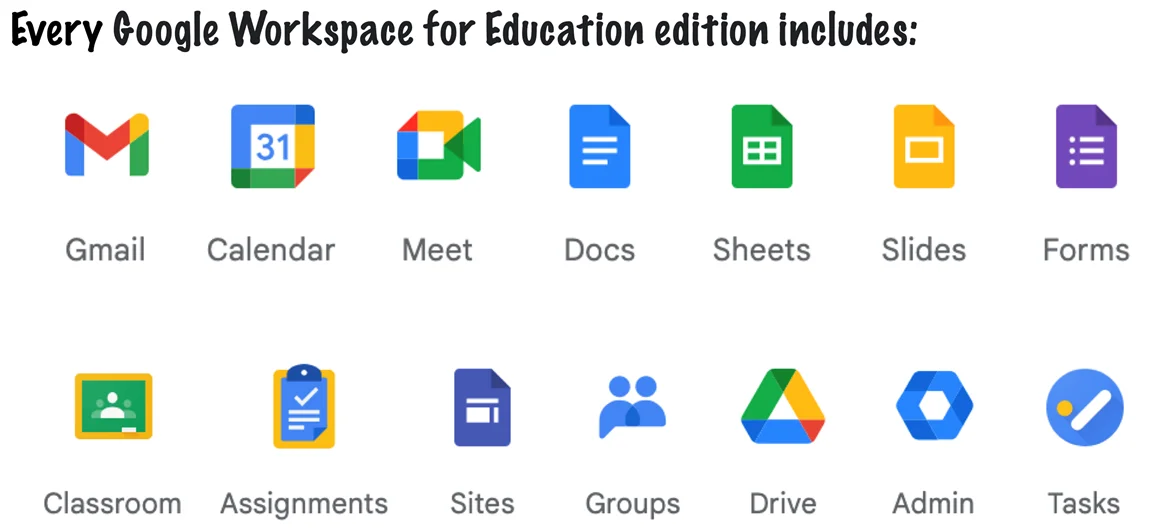
Funding is often the biggest obstacle for educators when it comes to implementing new technology in the classroom. Hence, it is important to use free resources wherever possible. Speaking of funding, a tablet is also a smart investment. It saves space by fitting thousands of textbooks into a single device.
Teachers have long recognized the importance of websites in accessing content, resources, and teaching materials. An increasing number of them have their students develop or share work on a website, wiki, or blog.
Services like WordPress, Squarespace, Wix, and Google’s own Sites make building and maintaining websites easier and more cost-effective than printed resources.
13. Classroom Apps Can Teach New Life Skills
Students transform into independent thinkers and contributors in the classroom, and technology can be a powerful enabler in this journey. It is here that they acquire skills such as conducting research, collaborating with others, using technology to drive productivity, structured problem-solving, and communication.
While access to data is easy, what truly matters is how one filters information to drive meaningful outcomes. Using technology helps students master these skills early on.
14. Using Technology in the Classroom Prepares Pupils for Future Workplaces
The skills needed in the future world of work will be very different from those of today. The classroom is an experimental playground where pupils learn such skills.
According to the Future of Jobs Report 2023 by the World Economic Forum, over 85% of organizations identify the adoption of frontier technologies and digital access as trends most likely to drive transformation.
Not only is technology altering the way we work, but it is also changing job content, skills in need, and which jobs are being displaced. The figure below shows various technologies companies believe they are likely to adopt by 2027:
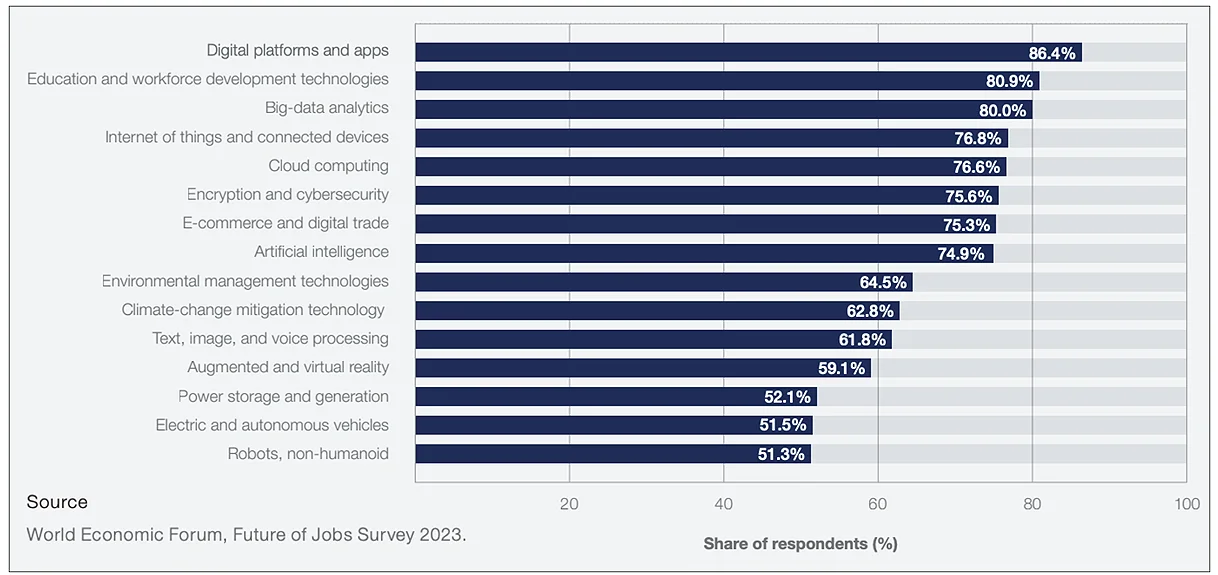
Students must be prepared to adapt quickly to an ever-changing technology landscape.
Integrating technology in the classroom equips them with the practical skills and adaptability they need to thrive in a digitally driven future. As teachers, it is our responsibility to adapt and change our methods to prepare them for this.
15. Using Technology in Teaching and Learning Can Improve Knowledge Retention
Mobile apps and Edtech software use adaptive learning algorithms to cater to individual learning styles and paces. These algorithms adjust educational content to the needs and abilities of each learner, offering tailored on-demand academic resources.
This can make education more student-centric and increase engagement and retention.
Many Ed-tech tools use spaced repetition techniques, such as digital flashcards that present information at intervals. This helps students review and recall information over time, which is beneficial for long-term memory retention.
Some apps also use interactive mind maps or concept maps that make it easier to visually connect new information with existing knowledge, fostering better understanding and retention.
The content presented on such platforms is often bite-sized and concise, meaning children are not overwhelmed by too much information in one go and can, therefore, retain more of what they learn.
16. No One Learns in the Same Way
Students have varying abilities and learning styles. Digital applications present brilliant opportunities for making education more effective.
Technology enables teachers to effectively address students’ diverse learning needs by adopting a hybrid approach of self-study, adaptive instruction, and peer network support.
For instance, technology allows students to learn at their own pace, slowing things down or allowing them to explore a topic in greater depth. Differentiation is easily achieved with tech.
Teachers can use technology to overcome barriers and deliver the same lesson in different ways. For example, show videos or invite students to play educational games.
17. Classroom Apps Accommodate Children With Special Needs or Disabilities
Classroom technology and apps can accommodate children with special needs or disabilities in several ways:
- Alternative Format of Instruction: Classroom apps provide alternative formats of instruction, such as visuals, graphic organizers, learning apps, and audiobooks, to help students with special needs process information more effectively.
- Make learning more accessible: There are several education apps specifically designed for special learning needs.
- Frequent Breaks: Taking breaks can help some students with special needs focus better. Many apps, like GoNoodle, provide mindfulness opportunities or exercise videos to offer students a break.
- Outlines, Note-Takers, or Recordings: help students with special needs better understand and retain information. For example, the Notability app provides support for students in note-taking, research, and more, while Time Timer is an excellent visual tool that can be helpful for students with special needs.
- Text-to-speech (TTS) software: can read digital text aloud, making it accessible for students with reading disabilities. It works with almost all digital devices.
- Speech Recognition: Found on most digital devices, speech recognition enables students to express themselves by simply talking without having to worry about typing, spelling, and grammar.
- Mindfulness Opportunities: provide mindfulness opportunities to help students with special needs manage stress and anxiety. For example, GoNoodle offers exercise videos and mindfulness activities to help students relax and focus.
It is also important to note that children with special needs and disabilities are often eligible for funding, which can be put towards specific technology to benefit the individual.
Special needs children are often eligible for funding that can be used to acquire technology for their benefit.
Overall, such classroom technology provides a more inclusive and accessible learning environment for students with special needs or disabilities.
18. Classroom Apps Encourage Creativity
Creativity cannot be taught; it must be nurtured through daily practice and inspiration. Many amazing apps and programs are available today that can encourage creativity, allowing children to draw, compose music, or make films with no extra tools required.
19. Assistance with Data Collection
Using technology in teaching and learning can make data collection much easier.
For instance, students can take pictures or screenshots of their work and save them to cloud-based services such as Google Drive. Teachers can use online surveys and polls to collect information about the impact and experience of educational programs, as well as to measure satisfaction or shifts in efficacy and mindsets.
Digital tools for formative assessment, such as those listed by NWEA, can help teachers gather real-time feedback on student learning and adjust instruction accordingly.
20. Digital Classroom Tools are Constantly Evolving
Education tools will continue to evolve constantly due to rapid technological advancements and the increasing demand for innovative ways to enhance learning experiences.
Big tech companies such as Google, Microsoft, and Apple are pouring big money into developing apps and entire learning environments. Google, for example, has committed more than $250 million since 2005 to tackling global education gaps.
Edtech startups, too, are thriving in a growing education technology sector and changing the way we learn.
According to one estimate by the World Economic Forum, 65% of children entering primary school today will ultimately end up working in completely new job types that don’t yet exist.
Students and teachers must develop the problem-solving skills and basic digital competencies that they’ll need to be prepared for the future. Tomorrow’s classrooms will be vastly different from the ones we grew up in and have previously taught in.
Teachers must look for new opportunities to use technology to improve their teaching practice. Failing to teach in a student’s world will lead to disengagement and hinder academic progress.

